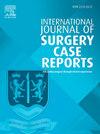混合旋转动脉粥样硬化切除术和机械支持下冲击波辅助复杂左主干PCI治疗1例高危出血患者,罕见病例报告
IF 0.6
Q4 SURGERY
引用次数: 0
摘要
高风险经皮冠状动脉介入治疗(PCI)与机械循环支持已成为冠状动脉旁路移植术(CABG)的替代方案,用于复杂的左主干冠状动脉疾病患者的高手术风险。病例介绍:一名69岁女性,患有糖尿病、高血压、高脂血症和既往卒中,并出现非st段抬高型心肌梗死。超声心动图显示左心室射血分数为25%。冠状动脉造影显示左主干远端严重钙化,伴有左前降支(LAD)和左旋支(LCX)动脉严重口狭窄。由于认为不适合冠脉搭桥,她接受了高风险PCI和Impella机械支持。旋转动脉粥样硬化切除术和血管内碎石术用于解决广泛的钙化。左主干至LCX行药物包被球囊血管成形术,左主干至lad中部放置药物洗脱支架。扩张后确保最佳的支架放置和血管通畅。在复杂的PCI手术过程中,机械循环支持提供了必要的血流动力学稳定性。先进的病变修复技术,包括旋转动脉粥样硬化切除术和血管内碎石术,对于治疗严重钙化病变,促进最佳支架部署和最小化手术风险至关重要。结论机械支持与先进介入技术相结合的混合PCI入路是治疗复杂冠状动脉疾病高危患者冠脉搭桥禁忌的有效方法。该策略为具有重大解剖和临床挑战的患者提供了可行的替代方案,强调了在当代介入心脏病学中定制治疗干预的重要性。本文章由计算机程序翻译,如有差异,请以英文原文为准。
Hybrid rotational atherectomy and shockwave-assisted complex left main PCI with mechanical support in a high-bleeding risk patient, a rare case report
Introduction
High-risk percutaneous coronary intervention (PCI) with mechanical circulatory support has emerged as an alternative to coronary artery bypass grafting (CABG) for patients with complex left main coronary artery disease who are at high surgical risk.
Case presentation
A 69-year-old woman with diabetes mellitus, hypertension, hyperlipidemia, and a prior stroke presented with non-ST-segment elevation myocardial infarction. Echocardiography revealed a left ventricular ejection fraction of 25 %. Coronary angiography showed heavily calcified distal left main disease with critical ostial stenosis of the left anterior descending (LAD) and left circumflex (LCX) arteries. Deemed unsuitable for CABG, she underwent high-risk PCI with Impella mechanical support. Rotational atherectomy and intravascular lithotripsy were employed to address extensive calcification. A drug-coated balloon angioplasty was performed from the left main to the LCX, and a drug-eluting stent was placed from the left main into the mid-LAD. Post-dilation ensured optimal stent apposition and vessel patency.
Discussion
Mechanical circulatory support provided essential hemodynamic stability during the complex PCI procedure. Advanced lesion modification techniques, including rotational atherectomy and intravascular lithotripsy, were crucial for treating the heavily calcified lesions, facilitating optimal stent deployment, and minimizing procedural risks.
Conclusion
The hybrid PCI approach combining mechanical support and advanced interventional techniques was effective in managing complex coronary artery disease in a high-risk patient contraindicated for CABG. This strategy offers a viable alternative for patients with significant anatomical and clinical challenges, emphasizing the importance of tailored therapeutic interventions in contemporary interventional cardiology.
求助全文
通过发布文献求助,成功后即可免费获取论文全文。
去求助
来源期刊
CiteScore
1.10
自引率
0.00%
发文量
1116
审稿时长
46 days

 求助内容:
求助内容: 应助结果提醒方式:
应助结果提醒方式:


